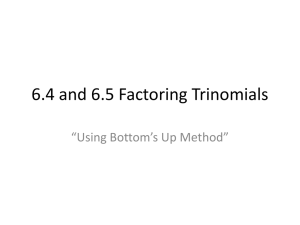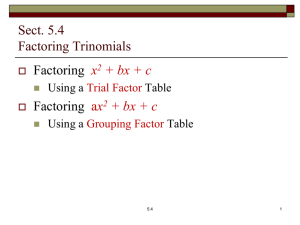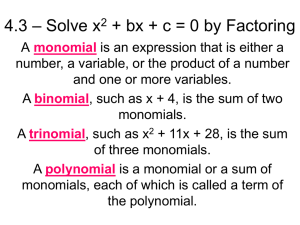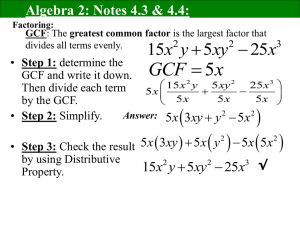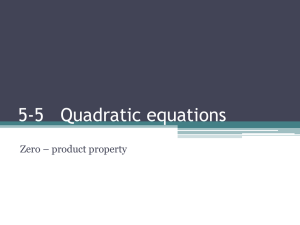Factor.
advertisement
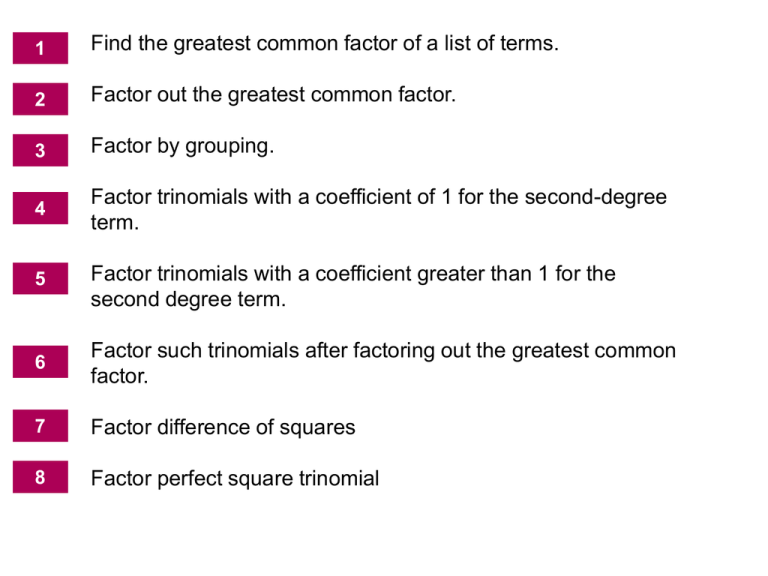
The Factor; Factoring FindGreatest the greatestCommon common factor of a list of terms. by Grouping 6.1 1 2 Factor out the greatest common factor. 3 Factor by grouping. 4 Factor trinomials with a coefficient of 1 for the second-degree term. 5 Factor trinomials with a coefficient greater than 1 for the second degree term. 6 Factor such trinomials after factoring out the greatest common factor. 7 Factor difference of squares 8 Factor perfect square trinomial The Greatest Common Factor: Factoring by Grouping To factor means “to write a quantity as a product.” That is, factoring is the opposite of multiplying. For example, Multiplying Factoring 6 · 2 = 12 12 = 6 · 2 Factors Product Product other factored forms of 12 are − 6(−2), 3 · 4, −3(−4), 12 · 1, and Factors −12(−1). More than two factors may be used, so another factored form of 12 is 2 · 2 · 3. The positive integer factors of 12 are 1, 2, 3, 4, 6, 12. Find the greatest common factor of a list of terms. An integer that is a factor of two or more integers is called a common factor of those integers. For example, 6 is a common factor of 18 and 24. Other common factors of 18 and 24 are 1, 2, and 3. The greatest common factor (GCF) of a list of integers is the largest common factor of those integers. Thus, 6 is the greatest common factor of 18 and 24. Recall that a prime number has only itself and 1 as factors. Factoring numbers into prime factors is the first step in finding the greatest common factor of a list of numbers. Find the greatest common factor of a list of terms. (cont’d) Factors of a number are also divisors of the number. The greatest common factor is actually the same as the greatest common divisor. The are many rules for deciding what numbers to divide into a given number. Here are some especially useful divisibility rules for small numbers. Find the greatest common factor of a list of terms. (cont’d) Finding the Greatest Common Factor (GCF) Step 1: Factor. Write each number in prime factored form. Step 2: List common factors. List each prime number or each variable that is a factor of every term in the list. (If a prime does not appear in one of the prime factored forms, it cannot appear in the greatest common factor.) Step 3: Choose least exponents. Use as exponents on the common prime factors the least exponent from the prime factored forms. Step 4: Multiply. Multiply the primes from Step 3. If there are no primes left after Step 3, the greatest common factor is 1. EXAMPLE 1 Finding the Greatest Common Factor for Numbers Find the greatest common factor for each list of numbers. Solution: 50, 75 GCF = 25 12, 18, 26, 32 GCF = 2 50 2 5 5 75 3 5 5 12 2 2 3 26 2 13 18 2 3 3 32 2 2 2 2 2 22 2 11 24 2 2 2 3 22, 23, 24 GCF = 1 23 1 23 Find the greatest common factor of a list of terms. (cont’d) The GCF can also be found for a list of variable terms. The exponent on a variable in the GCF is the least exponent that appears in all the common factors. EXAMPLE 2 Finding the Greatest Common Factor for Variable Terms Find the greatest common factor for each list of terms. Solution: 16r 9 , 10r15 , 8r12 16r 1 2 2 2 2 r GCF = 2r 9 10r15 1 2 5 r15 9 8r12 2 2 2 r12 s 4t 5 , s3t 6 , s9t 2 s 4t 5 s 4 t 5 GCF = s3t 2 s3t 6 s3 t 6 s 9t 2 s 9 t 2 9 Factor out the greatest common factor. Writing a polynomial (a sum) in factored form as a product is called factoring. For example, the polynomial 3m + 12 has two terms: 3m and 12. The GCF of these terms is 3. We can write 3m + 12 so that each term is a product of 3 as one factor. 3m + 12 = 3 · m + 3 · 4 = 3(m + 4) GCF = 3 Distributive property The factored form of 3m + 12 is 3(m + 4). This process is called factoring out the greatest common factor. The polynomial 3m + 12 is not in factored form when written as 3 · m + 3 · 4. The terms are factored, but the polynomial is not. The factored form of 3m +12 is the product 3(m + 4). EXAMPLE 3 Factoring Out the Greatest Common Factor Write in factored form by factoring out the greatest common factor. Solution: 6x 2 x 2 2 6 x 4 12 x 2 30t 25t 10t 6 5 r r 12 5t 4 6t 2 5t 2 4 r 10 10 r 2 1 8 p q 16 p q 12 p q 4 p q 2 p 4 p q 3q 5 2 6 3 4 7 4 2 2 5 Be sure to include the 1 in a problem like r12 + r10. Always check that the factored form can be multiplied out to give the original polynomial. EXAMPLE 4 Factoring Out the Greatest Common Factor Write in factored form by factoring out the greatest common factor. Solution: 6 p q r p q p q 6 r y4 y 3 4 y 3 y 3 y 4 4 Factor by grouping. When a polynomial has four terms, common factors can sometimes be used to factor by grouping. Factoring a Polynomial with Four Terms by Grouping Step 1: Group terms. Collect the terms into two groups so that each group has a common factor. Step 2: Factor within groups. Factor out the greatest common factor from each group. Step 3: Factor the entire polynomial. Factor out a common binomial factor from the results of Step 2. Step 4: If necessary, rearrange terms. If Step 2 does not result in a common binomial factor, try a different grouping. EXAMPLE 5 Factoring by Grouping Factor by grouping. Solution: pq 5q 2 p 10 q p 5 2 p 5 p 5 q 2 2 xy 3 y 2 x 3 y 2x 3 1 2x 3 2x 3 y 1 2a 4a 3ab 6b 2 2a a 2 3b a 2 a 2 2a 3b x3 3x 2 5x 15 x2 x 3 5 x 3 x 3 x 2 5 EXAMPLE 6 Rearranging Terms before Factoring by Grouping Factor by grouping. Solution: 6 y 2 20w 15 y 8 yw 6 y 2 15 y 20w 8 yw 3 y 2 y 5 4w 2 y 5 2 y 53 y 4w 9mn 4 12m 3n 9mn 12m 3n 4 3m 3n 4 13n 4 3m 13n 4 Factoring Trinomials Using the FOIL method, we see that the product of the binomial k − 3 and k +1 is (k − 3)(k + 1) = k2 − 2k − 3. Multiplying Suppose instead that we are given the polynomial k2 − 2k − 3 and want to rewrite it as the product (k − 3)(k + 1). That is, k2 − 2k − 3 = (k − 3)(k + 1). Factoring Recall that this process is called factoring the polynomial. Factoring reverses or “undoes” multiplying. Factor trinomials with a coefficient of 1 for the second-degree term. When factoring polynomials with integer coefficients, we use only integers in the factors. For example, we can factor x2 + 5x + 6 by finding integers m and n such that x2 + 5x + 6 = (x + m)(x + n). To find these integers m and n, we first use FOIL to multiply the two binomials on the right side of the equation: x m x n x22 nx mx mn. x n m x mn. Comparing this result with x2 + 5x + 6 shows that we must find integers m and n having a sum of 5 and a product of 6. Product of m and n is 6. x2 5x 6 x2 n m x mn. Sum of m and n is 5. Factor trinomials with a coefficient of 1 for the second-degree term. (cont’d) Since many pairs of integers have a sum of 5, it is best to begin by listing those pairs of integers whose product is 6. Both 5 and 6 are positive, so consider only pairs in which both integers are positive. Both pairs have a product of 6, but only the pair 2 and 3 has a sum of 5. So 2 and 3 are the required integers, and x2 + 5x + 6 = (x + 2)(x + 3). Check by using the FOIL method to multiply the binomials. Make sure that the sum of the outer and inner products produces the correct middle term. EXAMPLE 1 Factoring a Trinomial with All Positive Terms Factor y2+ 12y + 20. Solution: Factors of 20 1, 20 2, 10 4, 5 Sums of Factors 1 + 20 = 21 2 + 10 = 12 4+5 =9 y 10 y 2 You can check your factoring by graphing both the unfactored and factored forms of polynomials on your graphing calculators. EXAMPLE 2 Factoring a Trinomial with a Negative Middle Term Factor y2 − 10y + 24. Solution: Factors of 24 − 1 , −24 −2 , −12 −3 , −8 −4 , −6 Sums of Factors −1 + (−24) = −25 −2 + (−12) = −14 −3 + (−8) = −11 −4 + (−6) = −10 y 6 y 4 EXAMPLE 3 Factoring a Trinomial with a Negative Last (Constant) Term Factor z2 + z − 30. Solution: Factors of − 30 Sums of Factors − 1 , 30 −1 + (30) = 29 1 , − 30 1 + (−30) = −29 5,−6 5 + (− 6) = −1 −5 , 6 −5 + (6) = 1 z 6 z 5 EXAMPLE 4 Factoring a Trinomial with Two Negative Terms Factor a2 − 9a − 22. Solution: Factors of −22 Sums of Factors −1 , 22 1, −22 −2 , 11 2 , −11 −1 + 22 = 21 1 + (−22) = −21 −2 + 11 = 9 2 + (−11) = −9 a 11 a 2 Factor trinomials with a coefficient of 1 for the second-degree term. (cont’d) Some trinomials cannot be factored by using only integers. We call such trinomials prime polynomials. Summarize the signs of the binomials when factoring a trinomial whose leading coefficient is positive. 1. If the last term of the trinomial is positive, both binomials will have the same “middle” sign as the second term. 2. If the last term of the trinomial is negative, the binomials will have one plus and one minus “middle” sign. EXAMPLE 5 Deciding Whether Polynomials Are Prime Factor if possible. m 8m 14 2 Prime Solution: Factors of 14 Sums of Factors −1 , −14 −1 + (−14) = −15 −2 + (−7) = −9 −2 , −7 y y2 2 Prime Factors of 2 Sums of Factors 1, 2 1+2=3 Factor trinomials with a coefficient of 1 for the second-degree term. (cont’d) Guidelines for Factoring x2 + bx + c Find two integers whose product is c and whose sum is b. 1. Both integers must be positive if b and c are positive. 2. Both integers must be negative if c is positive and b is negative. 3. One integer must be positive and one must be negative if c is negative. Factor trinomials with a coefficient greater than 1 for the second-degree term. (Slide and Divide) Factor : 10x2 – 21x -10 Step 1: Multiply second degree coefficient and constant term. Remove second degree term and replace constant term with new constant term. x2 – 21x – 100 Step 2: Factor as if second degree coefficient is 1. (x–25)(x+4) -25 + 4 = -21; -25 x 4 = -100 Step 3: Divide each binomials constant term by original second degree coefficient. Reduce fractions if possible. (x-25/10)(x+4/10) (x-5/2)(x+2/5) Step 4: Multiply each binomial by the denominator of its constant term. (2x-5)(5x+2) Check by multiplying EXAMPLE 6 Factoring a Trinomial with Two Variables Factor r2 − 6rs + 8s2. Solution: Factors of 8s2 −1s , −8s −2s , −4s Sums of Factors − 1s + (−8s) = −9s −2s + (−4s) = −6s r 4s r 2s EXAMPLE 6 Factoring a Trinomial with Two Variables Factor 6m2 + 11mn – 10n2. Solution: 3m 2n 2m 5n 4mn 15mn 11mn EXAMPLE 7 Factoring a Trinomial with a Common Factor Factor such trinomials after factoring out the greatest common factor. If a trinomial has a common factor, first factor it out. Factor 3x4 − 15x3 + 18x2. Solution: 3x 2 x 2 5 x 6 3x2 x 3 x 2 When factoring, always look for a common factor first. Remember to include the common factor as part of the answer. As a check, multiplying out the factored form should always give the original polynomial. EXAMPLE 7 Factoring Trinomials with Common Factors Factor. 28x4 58x3 30 x2 24x3 32x2 y 6xy 2 Solution: 2 x 14 x 29 x 15 2 2 2x2 7x 3 2x 5 6x 35x 29 x 2 x 12 x 2 16 xy 3 y 2 2x 6x y 2x 3 y 2xy 18xy 16xy Factor a difference of squares. The formula for the product of the sum and difference of the same two 2 2 terms is x y x y x y . Factoring a Difference of Squares x2 y2 x y x y For example, m2 16 m2 42 m 4 m 4 . The following conditions must be true for a binomial to be a difference of squares: 1. Both terms of the binomial must be squares, such as x2, 9y2, 25, 1, m4. 2. The second terms of the binomials must have different signs (one positive and one negative). EXAMPLE 1 Factoring Differences of Squares Factor each binomial if possible. Solution: t 2 81 t 9t 9 r 2 s2 r s r s y 2 10 prime q2 36 prime After any common factor is removed, a sum of squares cannot be factored. EXAMPLE 2 Factoring Differences of Squares Factor each difference of squares. Solution: 49 x 2 25 7x 5 7x 5 64a 2 81b2 8a 9b8a 9b You should always check a factored form by multiplying. EXAMPLE 3 Factoring More Complex Differences of Squares Factor completely. Solution: 50r 32 2 25r 2 16 z 100 z 2 10 z 2 10 z 4 81 z 9 z 9 2 4 2 2 2 5r 45r 4 z 2 9 z 3 z 3 Factor again when any of the factors is a difference of squares as in the last problem. Check by multiplying. Factor a perfect square trinomial. The expressions 144, 4x2, and 81m6 are called perfect squares 2 because 2 2 4 x 2 x , and 81m6 9m3 144 12 , 2 . A perfect square trinomial is a trinomial that is the square of a binomial. A necessary condition for a trinomial to be a perfect square is that two of its terms be perfect squares. Even if two of the terms are perfect squares, the trinomial may not be a perfect square trinomial. Factoring Perfect Square Trinomials 2 2 2 x 2 xy y x y x 2 2 xy y 2 x y 2 EXAMPLE 4 Factoring a Perfect Square Trinomial Factor k2 + 20k + 100. Solution: k 20k 100 2 k 10 2 Check : 2 k 10 20k EXAMPLE 5 Factoring Perfect Square Trinomials Factor each trinomial. Solution: x 2 24 x 144 x 12 2 25x 2 30 x 9 5 x 3 2 36a 2 20a 25 prime 18 x 84 x 98 x 2 x 9 x 2 42 x 49 3 2 2 x 3x 7 2 Factoring Perfect Square Trinomials 1. The sign of the second term in the squared binomial is always the same as the sign of the middle term in the trinomial. 2. The first and last terms of a perfect square trinomial must be positive, because they are squares. For example, the polynomial x2 – 2x – 1 cannot be a perfect square, because the last term is negative. 3. Perfect square trinomials can also be factored by using grouping or the FOIL method, although using the method of this section is often easier. Factor a difference of cubes. Factoring a Difference of Cubes positive x 3 y 3 x y x 2 xy y 2 same sign opposite sign This pattern for factoring a difference of cubes should be memorized. The polynomial x3 − y3 is not equivalent to (x − y )3, x y whereas 3 x y x y x y x y x 2 2 xy y 2 x 3 y 3 x y x 2 xy y 2 EXAMPLE 6 Factoring Differences of Cubes Factor each polynomial. Solution: x3 216 x 6 x 2 6 x 36 27 x 8 3x 2 9 x 2 6 x 4 5x 5 5 x 3 1 3 3 64x 125 y 3 6 5 x 1 x 2 x 1 4 x 5 y 2 16 x 2 20 xy 2 25 y 4 A common error in factoring a difference of cubes, such as x3 − y3 = (x − y)(x2 + xy + y2), is to try to factor x2 + xy + y2. It is easy to confuse this factor with the perfect square trinomial x2 + 2xy + y2. But because there is no 2, it is unusual to be able to further factor an expression of the form x2 + xy +y2. Factor a sum of cubes. A sum of squares, such as m2 + 25, cannot be factored by using real numbers, but a sum of cubes can. Factoring a Sum of Cubes positive x3 y 3 x y x 2 xy y 2 same sign opposite sign Note the similarities in the procedures for factoring a sum of cubes and a difference of cubes. 1. Both are the product of a binomial and a trinomial. 2. The binomial factor is found by remembering the “cube root, same sign, cube root.” 3. The trinomial factor is found by considering the binomial factor and remembering, “square first term, opposite of the product, square last term.” Methods of factoring discussed in this section. EXAMPLE 7 Factoring Sums of Cubes Factor each polynomial. Solution: p 4 p 2 4 p 16 p3 64 27 x 64 y 3 512a b 6 3 3 3 x 4 y 9 x 12 xy 16 y 2 8a 2 b 64a 4 8a 2b b 2 2

